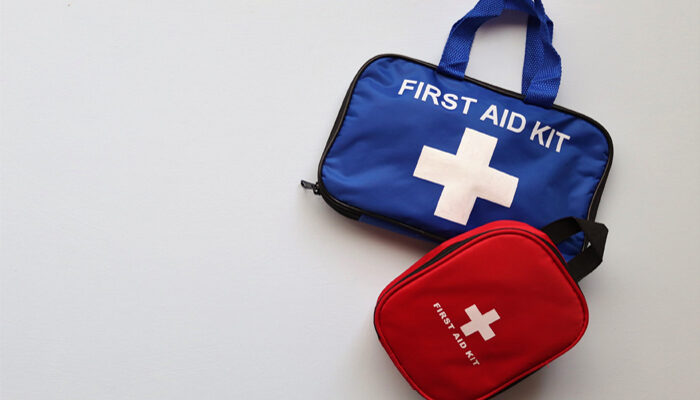
Cuts, scrapes, burns … accidents happen all the time. Serious issues will likely require a trip to the ER or urgent care. But, there are plenty of common mishaps that you treat right at home — if you have a first aid kit on hand.
Whether you live in your first apartment or your dream house, every home needs a first aid kit. You can buy fully assembled kits at almost any drug store or pharmacy, but you can also put one together yourself.
The next time an emergency arises, you should be prepared. Here are nine essential items that belong in every apartment’s first aid kit.
1. Adhesive Bandages
Bandages come in all shapes and sizes, and it’s best to have an assortment of small and large bandages in your kit at all times.
It’s easy to shatter a glass, nick your finger while cutting vegetables, or burn yourself while cooking. And if you do, you’ll need a bandage to cover up that cut or blister.
2. Sterile Gauze
Bandages with self-adhesive tape are great for small areas, but larger wounds may require gauze pads or gauze strips.
If you stock your first aid kit with gauze strips, be sure that you also have a pair of scissors to cut the strips down to the right size. In addition, have some safety pins or medical tape on hand to keep the gauze in place until you can see a medical specialist.
3. Alcohol-Free Cleansing Wipes
When you get a cut, your instinct may be to just slap on a bandage and forget about it. But it’s important to clean the injured area and remove all bacteria before applying a bandage or gauze.
Alcohol-free cleansing wipes clean, disinfect, and prepare the injured area without causing a sting. You can use one whether or not you need to apply a bandage on top.
4. Antiseptic Ointment
Antiseptic ointment is essential in treating scrapes, burns, and minor cuts. Products like Neosporin can prevent bacteria growth and help to promote the healing of wounds.
Antiseptic ointments and antibiotic creams should be applied directly to the skin, and a bandage or wound dressing can be applied on top.
5. Insect Bite/Sting Spray
If you’ve ever been stung by a bee or bitten by a mosquito, you know just how painful it can be. Make sure to always have a topical spray or cream that you can apply to relieve the sting and itch from bug bites.
6. Pain Relievers
Over the counter pain relievers, such as aspirin or Ibuprofen, are a must-have in every first aid kit. Pain relievers aren’t only for headaches and muscle pains — they also reduce inflammation and can help bring down a high temperature.
7. Emergency Eye Wash
An emergency eye wash is the sort of first aid supply you always need on hand yet hopefully never have to use. If you accidentally splash bleach, chemicals, or cleaning products in your eye, you’ll need a sanitary eye wash to flush and clean the eye safely.
It’s also a good idea to have some eye dressings in your supply kit in case you ever get a cut or scrape on or around the eye or eyelid.
8. Antihistamine
Antihistamines, as either cream or tablets, are the most effective way to relieve the symptoms of allergies and allergic reactions. From itchy skin to nasal congestion, an antihistamine is one of those first aid products that you’re likely to use at some point in time.
Keep in mind that antihistamines do not interact well with some other medications, such as beta-blockers and high blood pressure meds. If you are on any other type of medication, consult with your physician or pharmacist so that you know which ones are safe to combine.
9. Disposable Sterile Gloves
When you cut yourself and see blood, your instinct might be to clean and dress the wound as quickly as possible. But you should only do so with clean, washed hands.
In those moments when your main concern is to stop the bleeding, washing your hands can take precious time. In a situation like this, a pair of disposable, sterile gloves will come in handy.
Should you ever need to tend to another person’s wounds, you should always put on sterile gloves first. This should be done before cleaning, rinsing, or applying any sort of ointment or bandage to the skin.
Additional First Aid Supplies to Have on Hand
Walk up and down the aisles of any pharmacy or drugstore, and you’ll see endless rows of products for first aid treatment. And while the items listed above are the most essential, there are a variety of other items you should consider adding to your at-home first aid kit:
- Cold compress for reducing pain and swelling
- Digital thermometer to check your temperature
- Tweezers for removing splinters, glass, or debris
- Hand sanitizer if soap and water are unavailable
- Aluminum finger splint to stabilize a broken or sprained finger
- An extra EpiPen (or similar auto-injector) if you are at risk of an allergic reaction
It is also a good idea to have a first aid manual on hand, but don’t wait until a crisis arises to read it.
Instead, brush up on how to clean and treat common household injuries before an accident happens. That way, you’ll be prepared with both the products and the information needed to treat your ailment.
Conclusion
You never know when an accident might happen, so it’s important to always keep a fully stocked first aid kit on hand. And while dry items, such as gauze and bandages, will last for years, medications and ointments do expire.
To be safe, check the items in your first aid kit every few months, and replace expired products with new ones. If an emergency does arise, you’ll want to have a complete kit of safe and effective products on hand!
[Client Bio]

Caitlin Sinclair is the property manager at Harmony 3900. She is passionate about her community and loves making Harmony 3900 a place to call home.
Leave a Reply